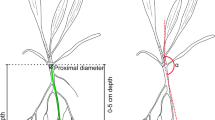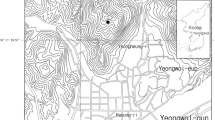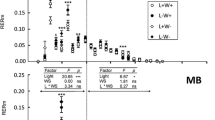Abstract
Actaea spicata and Geranium sylvaticum are deciduous rosette herbs, frequently coexisting in nutrient-rich forests of boreal Sweden. A. spicata is restricted to this habitat whereas G. sylvaticum has a wider ecological amplitude. To explore the different distributions of these species we studied the growth mechanisms by which they responded to nutrient and light supply. Plants raised from seeds were grown under four combinations of light and nutrient supplies and growth was followed for 20 weeks. Growth responses were measured as biomass accumulation and meristem activity, i.e. leaf development by shoot meristems. Biomass accumulation and meristem activity were affected by nutrient and light treatments. However, A. spicata responded more to nutrients, whereas G. sylvaticum responded more to light, and low resource supply shortened the time during which shoot meristems of A. spicata developed leaves without a corresponding effect on biomass accumulation. In G. sylvaticum, the periods of leaf development and biomass accumulation were the same, but a relationship between high development rates and peak allocation of biomass to shoot meristems indicated a storage function of these during leaf development. We conclude that the inflexible growth of A. spicata, mainly affected by nutrient supply, makes it less competitive in open habitats and restricts it to shaded, nutrient-rich habitats. G. sylvaticum should be more successful in habitats subjected to unpredictable disturbances, due to a flexible growth morphology and a dynamic function of meristems that buffers against variation in nutrient supply and facilitates positive light responses. Meristematic data should be included in interspecific comparisons on growth responses to different resource supplies. Unless species have the same growth mechanism, it is not satisfactory to study biomass-related traits alone, as internal constraints concerning plant development might confuse the interpretation.
Similar content being viewed by others
References
Aarsen IW, Taylor DR (1992) Fecundity allocation in herbaceous plants. Oikos 65: 225–232
Aerts R, Boot RGA, Aart PJM van der (1991) The relation between above- and belowground biomass allocation patterns and competitive ability. Oecologia 87: 551–559
Benner BL, Watson MA (1989) Developmental ecology of mayapple: seasonal patterns of resource distribution in sexual and vegetative rhizome systems. Funct Ecol. 3: 539–547
Bradshaw AD (1965) Evolutionary significance of phenotypic plasticity in plants. Adv Genet 13: 115–155
Chapin FS III, Shaver GR (1985) Individualistic growth response of tundra plant species to environmental manipulations in the field. Ecology 66: 564–576
Ericson L, Oksanen L (1987) The impact of controlled grazing by Clethrionomys rufocanus on experimental guilds of boreal forest floor herbs. Oikos 50: 403–416
Fagerström T (1992) The meristem-meristem cycle as a basis for defining fitness in clonal plants. Oikos 63: 449–453
Garnier E (1991) Resource capture, biomass allocation and growth in herbaceous plants. Trends Ecol Evol 6: 126–131
Garnier E (1992) Growth analysis of congeneric annual and perennial grass species. J Ecol 80: 665–676
Geber MA (1990) The cost of meristem limitation in Polygonum arenastrum: negative genetic correlations between fecundity and growth. Evolution 44: 799–819
Gould SJ, Lewontin RC (1979) The spandrels of San Mareno and the Panglossian paradigm: a critique of the adaptionist programme. Proc R Soc Lond Ser B 205: 581–598
Hardwick RD (1986) Physiological consequences of modular growth in plants. Philos Trans R Soc Lond B313: 161–173
Harper JL, White J (1974) The demography of plants. Annu Rev Ecol Syst 5: 419–463
Hultén E (1971) Atlas of the distribution of vascular plants in northern Europe. Generalstabens Litografiska Anstalt, Stockholm
Ingestad T, Ågren GI (1991) The influence of plant nutrition on biomass allocation. Ecol Applic 1: 168–174
Jonasson S, Chapin FS III (1985) Significance of sequential leaf development for nutrient balance of the cotton sedge, Eriophorum vaginatum L. Oecologia 67: 511–518
Jonasson S, Widerberg B (1988) The resource balance of Milium effusum with emphasis on environmental supply. Oecologia 76: 11–19
Law R (1979) Ecological determinants in the evolution of life histories. In: Anderson RM, Turner BD, Taylor LR (eds) Population dynamics. (British Ecological Society Symposium 20) Blackwell, Oxford, pp 81–103
Mahall BE, Bormann FH (1978) A quantitative description of the vegetative phenology of herbs in a northern hardwood forest. Bot Gaz 139: 467–481
Miao SL, Bazzaz FA (1990) Responses to nutrient pulses of two colonizers requiring different disturbance frequencies. Ecology 71: 2166–2178
Novoplansky A, Cohen D, Sachs T (1994) Responses of an annual plant to temporal changes in light environment: an interplay between plasticity and determination. Oikos 69: 437–446
Perttula U (1941) Untersuchungen uber die generative und vegetative Vermehrung der Blütenpflanzen in der Wald-, Hainwiesen und Hainfelsenvegetation. Ann Acad Sci Fenn Ser A 58
Poorter H, Remkes C (1990) Leaf area ratio and net assimilation rate of 24 wild species differing in relative growth rate. Oecologia 83: 533–559
Salomonson A, Ohlson M, Ericson L (1992) The effect of potassium on growth and nutrient uptake in two forest herbs with different chemical defence systems. Oikos 65: 493–501
SAS Institute Inc. (1985) SAS user's guide: statistics, version 5. SAS Institute Inc., Cary, N.C.
Schmid B (1992) Phenotypic variation in plants. Evol Trends Plants 6: 45–60
Steeves TA, Sussex IM (1989) Patterns in plant development. Cambridge University Press, Cambridge
Tuomi J, Vuorisalo T (1989) Hierarchical selection in modular organisms. Trends Ecol Evol 4: 209–213
Watkinson AR (1988) On the growth and reproductive schedules of plants: a modular viewpoint. Acta Oecol 9: 67–81
Watson MA (1984) Developmental constraints: effects on population growth and pattern of resource allocation in a clonal plant. Am Nat 123: 411–426
Watson MA (1990) Phenological effects on clone development and demography. In: Groenendael J van, Kroon H de (eds) Clonal growth in plants. SPB, The Hague, pp 43–55
Weier TE, Stocking CR, Barbour MG, Rost TL (1982) Botany: an introduction to plant biology. Wiley, New York
Young JE (1975) Effects of the spectral composition of light sources on the growth of a higher plant. In: Evans GC, Bainbridge R, Rackham O (eds) Light as an ecological factor. II. (The British Ecological Society Symposium 16) Blackwell, Oxford, pp 135–160
Zimmerman JK, Whigham DF (1992) Ecological functions of carbohydrates stored in corms of Tipularia discolor (Orchidaceae). Funct Ecol 6: 575–581
Author information
Authors and Affiliations
Rights and permissions
About this article
Cite this article
Salomonson, A., Ohlson, M. & Ericson, L. Meristem activity and biomass production as response mechanisms in two forest herbs. Oecologia 100, 29–37 (1994). https://doi.org/10.1007/BF00317127
Received:
Accepted:
Issue Date:
DOI: https://doi.org/10.1007/BF00317127




